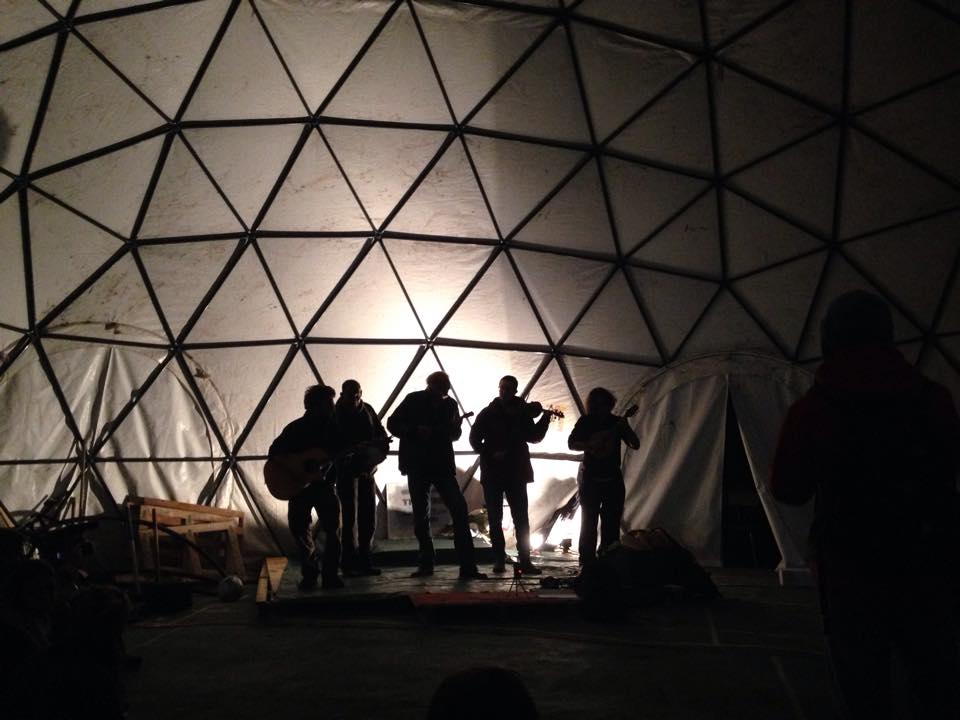The Music of the Calais Migrants

Ed Emery
It all starts with the drum. Not just any old drum but the darbuka drum. It has a long-standing, ancient history in the Mediterranean and Arab world. I am an ethnomusicologist, and I do musical research at the School of Oriental and African Studies in London. SOAS for short. The drum… is my methodology. Tamburology, I like to call it. The drum helps me to do my musical research. It also helps to make moments of musical solidarity. If you’ll permit me, I’ll explain.
In October we took a cross-Channel ferry from Dover to Calais in Northern France. “We” was a group of 30 students, musicians and activists from SOAS. This was a journey of solidarity with the 6,000 refugees, migrants and asylum seekers who are in that town. They’re trying to reach Britain and what they hope will be a better life.
But Britain’s borders are firmly shut, so they are stuck there, camped out in terrible conditions on the sand dunes at the edge of the North Sea. They call it the Jungle. The conditions are not helped by the well-documented habit of the riot police, of firing rounds of teargas into the camp. Happened again last night. Clouds of gas billowing round their little tent-towns at night when they’re asleep.
It’s a long walk from the town centre to the jungle. I’m walking on my own. As I walk the long walk, a group of men is heading in the same direction. They are Syrians. Newly arrived at the sand dunes. Apprehensive, unsure of this territory, labouring with the weight of their rucksacks and stopping once in a while to swap hands carrying their smaller bags. Their faces are world-weary, strained by the tiredness of a long travel, a long travail.
But I have a strong sense of agency, hope, energy and determination among these people who have made it through thick and thin to arrive in this war zone at the northern borders of Fortress Europe. The comradeship of the journey. I see elements here of human freedom, independence, beauty and joy in life. I say this because I have watched how the various nationalities in the jungle organise the daily lives of their communities and how individuals are working to build their little houses and tent-clusters in among the sandy hillocks of the sea-coast.
One house in particular I shall never forget. Its supporting structure is 3×2 wooden beams dug deep into the sand. At six feet off the ground it has a floor, constructed of wooden pallets retrieved from the factories of the surrounding industrial estates. On that floor, at one end, a little wooden shack, with walls of overlapping wooden slats, little windows open to the sea breeze and a corrugated roof well battened against eventual storms. At the other end a raised verandah with reclining chairs and a sea view. The sheltered undercroft houses a seating area for relaxing and conversation, with chairs salvaged from who knows where. The boy in me – who has never outgrown his love of dens – says yes, this is a grand place… can I come and join you…
The drum has a way of doing its magical work. As I walk the walk, someone from the other side of the road calls to me. Four men, one in a red keffiyeh, walking in the sun, back to the jungle. They point to my drum and beckon me across. Narrowly avoiding being run down by a passing truck I go to join them by the wall. They take the drum, all silvery-shiny as it is, and finger it lovingly, getting a sense of its weight, its balance and its tone. One of the men behind to tap out a rhythm, and then builds it in intensity. His friend with the headscarf joins him, head to head, squatting on the pavement, and with a kind of call and response they sing a song from their home country, laughing and smiling the while. I have no idea what the song was about – indeed afterwards they told me that it wasn’t really about anything at all.
These men are Iraqis. They are Kurds. They are from Suleimaniyah. And in the minutes that we pass together they are deeply, deeply happy. And then we part, them on their way and me on mine.
And sometimes – as happened with a group of Iranian refugees that I met in the camp later – the drum manages to engage the whole community.
The singer sings, the drum rings out its rhythms, and friends and family join in joyous dance. These are no more than moments. But they are moments of human solidarity. Around music, and around the drum. A moment’s escape from this desolate, alien, racist and hostile terrain through which their life’s trajectory has taken them…
Photos: Himasha S. Weera





